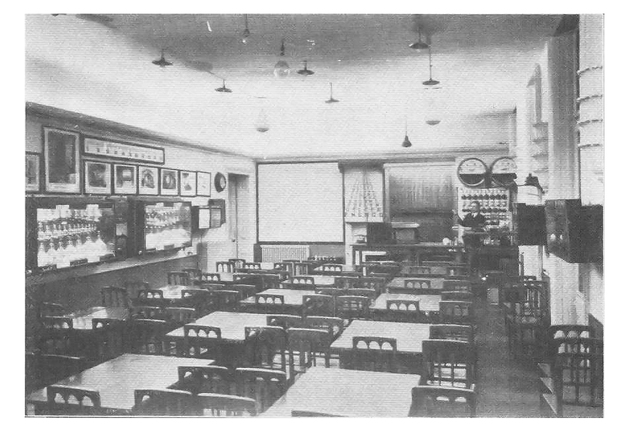Development of a Lighting Culture in Hungary
Nowadays, with light pollution a global challenge, it is hard to imagine that around a century ago the lighting problem confronting people was exactly the opposite: insufficient or inefficient lighting! That problem existed in many countries – and in most of Hungary. Proper lighting is crucial for physical and mental health, for raising productivity and creating safe and festive environments, while its underlying technology and consumer behavior together make clever energy management possible. In the late 1920s, these ideas had just started to become known in Hungary to a wider public, with the Lighting Engineering Station, opened in September 1927, and Tungsram playing a leading role in that transforming process. Let’s see how it all started.
From the late 19th century, electrical energy gradually gained ground in industry as a motive power, parallel to street and public lighting. In 1929, while half of the Hungarian population lived in localities with electric facilities, only 28% of all households used electricity for lighting. Moreover, this population was concentrated in large towns and around the coal mines while well over 2000 localities had no access to electricity at all. Due to a concentration of industrial production and more than 10% of the population centered in Budapest, the capital consumed around 50% of the electricity. Despite the progress of electrification in the 1920s – led mostly by the large mining companies in the countryside – a lot of room remained for improvement.
The obvious shared interest in promoting electricity consumption and installing electric lighting prompted the National Alliance of Electric Power Plants and Tungsram to establish the Lighting Engineering Station in September 1927. Tungsram remained the Station’s main sponsor for decades. In the interwar era, the Lighting Engineering Station, directed by Ferenc Zipernovszky, led the way in disseminating knowledge about proper lighting and played a consulting role in all issues concerning lighting, such as standardization or issuing regulations for lighting; the station also participated in planning floodlighting projects.

The lecture hall of the Lighting Engineering Station
The Lighting Engineering Station organized proper courses on lighting and held general presentations at secondary schools, for companies and various organizations, as well as for higher educational institutes such as the National Rationalization Committee, the National Congress for Publicity or the Trade Academy in Budapest. Cooperating with the power plants, the Lighting Engineering Station supported the spread of knowledge in the countryside as well, by preparing standardized lectures, leaflets and films, so as participating in events such as the National Agricultural Exhibition or the National Exhibition of the Education of Industrial Apprentices. The importance of combining direct and indirect lighting – to decrease the luminosity of lights that are too bright and to adjust lighting to individual needs – was one major message combined with the importance of augmenting light intensity in general, in order to raise productivity and protect people’s eyesight. Teachers, doctors, constructing engineers and applied art designers were identified as major stakeholders who would introduce the importance of proper lighting into schools, hospitals and various construction projects. The psychological effects of proper lighting were recognized, with contests of window displays organized for a large attendance.
As women were in charge of households, the Lighting Station paid special attention to inform women about the best methods of saving on electricity while providing proper lighting and taking care of the eyesight of their loved ones. The Station’s 1933/34 report observed an unexpectedly high interest for practical technical knowledge on the part of women, even domestic servants, about various electrical household appliances (hoover, hairdryer, water tanks, refrigerator, electric stove), which were not yet widely in use, but were expected to make household work easier. The realization of these dreams depended on the progress of electrification and on the households’ budget to use electricity for other purposes beyond lighting.

Proposed lighting in a living room in 1934 compared to the end of the 19th century
Floodlighting was a fashionable and highly attractive novelty in the 1920s, and the Budapest Municipal Office of Tourism did not want this innovation to slip them by. The Tourism Office prepared a temporary floodlighting installation of the Fishermen’s Bastion for 20th August, 1928, according to the plans by the Lighting Economy Department of Tungsram and with the leading electrical and cable factories’ material contribution. This successful experiment paved the way to impressive floodlighting projects of the 1930s, led by the Budapest Municipal Electricity Works, culminating in the festive illumination of Budapest on the occasion of the Eucharistic World Congress in 1938 (St. Stephen’s Basilica, the Tunnel, statue lightings, illumination of the open-air altar on Heroes’ Square). Tungsram and the Lighting Engineering Station participated in these projects with the knowledge gathered from other projects in foreign countries, experimenting with various illuminating methods, designing some of the illuminations and of course, as a supplier of lamps and fixtures.

Tungsram poster with a festive illumination of Budapest

Stream contemporary news about the evening procession at the Eucharistic World Congress
(interesting points from the point of view of lighting: 0:00-0:06, 0:56-1:12)
https://filmhiradokonline.hu/watch.php?id=2812
Sources:
Herrmann Miksa kereskedelmi miniszter a villamosításról, a villamosítási törvényről és az Ausztriával valό villamosenergia kicserélésről, in: Pesti Tőzsde 10 (1929) 20, 1.
Horváth, József, The Floodlighting of Budapest. Hungexpo, Budapest, 1990.
Horváth, József, 75 éves a Világítástechnikai Állomás – ünnepi megemlékezés vagy nekrológ? In: Világítástechnikai Évkönyv 2002-2003, 5-11.
Kaesz, Gyula, Korszerű világítótestek. Tér és Forma 7 (1934), 4-5, 118-125.
Szilas, Oszkár, Die Elektrizität erzeugende Industrie. Ungarisches Wirtschaftsjahrbuch 1929, p. 115.
Zipernovszky, Ferenc, A Világítástechnikai Állomás működése és a világítástechnika általános fejlődése 1933/34-ben. Miskolci Könyvnyomda Rt., Budapest, 1934.
Nemzeti Filmintézet Magyarország, Filmarchívum (National Film Institute, Film Archive) (Rights of use: https://filmhiradokonline.hu/en.php)
Tungsram Gyártörténeti Gyűjtemény (Tungsram Historical Collection)





